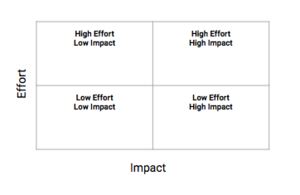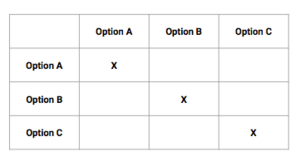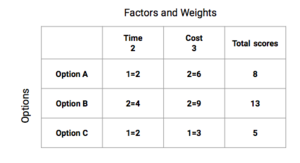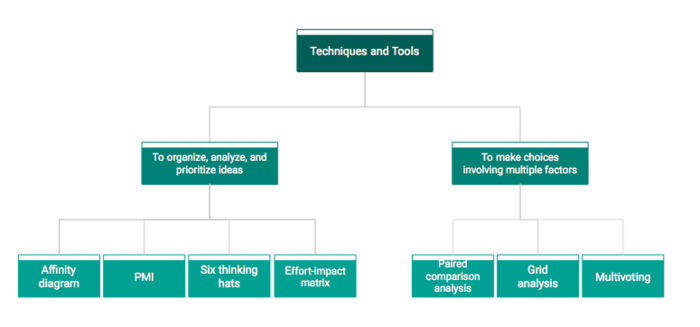Meeting Management
Contents |
Abstract
Meetings play a significant role in existing and upcoming projects. They are one of the main keys for group decision making, communications and problem-solving.
Multitudinous variables answerable exist for creating profitable and productive meetings where the decisive key is positive collaboration towards action.
The first part is mainly directed for management portfolio review meetings which are considered as overwhelming, time-consuming and unproductive[1].
In conjunction with the need for the portfolio review meetings, the four types of meetings are mentioned to determine the format and urgency of the assemble.
The second part briefly describes all steps that assure constructing well-organized meeting, from preparing, starting through conducting, closing the meeting until following up after. The conducting part is extended with the several tools and techniques (displayed thinking, affinity diagram, PMI etc.) which enable engagement of employees and lead to effective problem-solving. The explanation of the usage of the tools and techniques, as well as when it is appropriate to use them, is mentioned.
Finally, the financial investment in meetings is considered and the three-stage model is presented to approach for maximizing the potential of meetings[2].
Portfolio Review Meetings
The management of meetings is an effortful and challenging process, especially for portfolio reviews What is more it is undeniable that portfolio review meetings are overwhelming, overdue and oftentimes unproductive.
Therefore, selecting appropriate existing options aligned with meeting procedure and presented techniques allows performing this sort of assembly more efficiently and effectively.
Firstly, it is worth to mention that different kinds of organizations have a different point of view for what purpose the meeting is organized. For some, the main plan is to review the project status of all existing projects in the portfolio, whereas for some the objective is to evaluate each project to update the priorities and procedures. Keeping in mind this information, the four different options for conducting the meeting are proposed[1].
Option 1 is intended to review all in-flight projects, their priorities, key values, and status. The options are mostly recommended inside the organization where the balance between all the projects has remained and no action is required.
Option 2 is meant to review only projects in the portfolio with high-risk value. It allows detecting possible emergency and uncertainty, therefore enables the change of priorities in certain projects before the failure comes.
Option 3 is based on reviewing all projects in the portfolio with high-level quality to update all the project priorities.
Option 4 is found on reviewing portfolio scenarios that are accurate to the current business needs to be followed, and therefore the selection of the most recommended and valuable portfolio scenario for the organization[1].
The final decision of the selected options belongs to the main owner of the portfolio. However, it is asserted that option 4 seems to be the most convenient approach for conducting portfolio meetings. Instead of misusing the focus on individual projects, the governance team reviewing the portfolio scenarios previously compiled by the portfolio team. Different scenarios support different goals that play a crucial role in the current business.
With the following scenarios, the meeting can be performed more efficiently and making the decision is predicted to be less time consuming and profitable.
The range of portfolio scenarios presented in the meeting should include[[3]:
- Growth Scenario;
- Customer Growth Scenario;
- Market Growth Scenario;
- Reduced R&D Spend Scenario;
- Balanced Portfolio Scenario.
Steps for conducting the meeting
Meetings are not the one stage activity. The well-organized effective meeting includes the four other steps that should be performed, from preparing, starting through conducting, closing the meeting and follow up after. However, the rest of the steps is often neglected or treated as less important, while they play the main key for the effectiveness.
Meeting Preparation
Preparing is the decisive element of effective meeting performance. More time reserved for preparation decreases both: the time spent and the time wasted during the meeting. However, before organizing the meeting, the simple question has to be asked: is the meeting needed? [4] In that specific case, it is obviously clear that all projects need to be updated. (By canceling the unnecessary assemblies, the employees should be informed that their time is valuable. Therefore, the meeting should be considered only if the group interaction is required to solve the problem or make the decision.) To summarize, the final goal or purpose of the meeting need to be defined. After the decision of making the meeting is made proper attendees should be invited. Then the preparation of agenda should be developed. The main objective of the agenda should direct the point of the whole assembly. If the agenda is not clearly constructed, or the organizer is not totally certain, virtual brainstorming is recommended in order to cover all the possible considerations[5]. The agenda should be provided to attendees in advance to allow them relevant preparation that possibly would result in a shorter time and more effective meeting. In that step, time and meeting location should be taken into consideration. In that specific case, the material preparation should be started in advance, f.ex. for option 4. All portfolio scenarios need to be prepared and the meeting only should focus on reviewing them and selecting the best possible option.
Starting Meeting
The meeting should be started on time. However, for a large group, the official start time can include 10-15 minutes time in advance for latecomers. Before the meeting, the most practical roles should be assigned: scribe, timekeeper, and note-taker should be chosen. It is better to make an arrange those roles before starting the meeting to improve their preparation and avoid wasting time. [6] Another step is to present the agenda and basically assure that all in all is understandable and clear. What is more, the ground rule of the meeting should be established. It includes promoting respect, collaboration, and efficiency of all the participants. The facilitator is responsible for initiating the start of the discussion. [7]
Conducting Meeting
When it comes to the main point of problem-solving, decision making, the facilitator is also responsible for guiding attendees through a planned agenda and prevent form delays. In case of delays, it might be recommended to omit some points of agenda and focus on the most important to avoid decreasing engagement that is aligned with the time. Moreover, the most relevant and demanding part - the discussion, should follow with an opening, managing participation, keeping the discussion focused and closing the discussion[5]. Obviously, in real life, not everything goes with the plan. The discussion might generate more issues, but the facilitator is own the final decision if the discussion should be concerned or not.
Closing Meeting
When the time arrives is almost up, or when the meeting objectives are obtained, the meeting should be closed. In case if the decision is not made and the problem is not solved, another meeting can be planned. In this special case, to make the final decision exists three possibilities[5]:
- Voting by majority or plurality,
- Consensus-cooperative development of decision which is approved by all groups members,
- Delegation, where the selected attendees make the final decision.
Techniques and tools for conducting meeting
Different options for reviewing portfolio suggest using different techniques and tools while conducting the meeting [5]. Figure 2 presents which tool should be used for different cases.
To organize, analyze, and prioritize ideas
Different options for reviewing portfolio suggest using different techniques and tools while conducting the meeting, where the projects need to be organized, analyzed and ideas prioritized, the affinity diagram, PMI, six thinking hat and effort-impact matrix are recommended. The brief description of each tool and the procedure to perform the technique is given.
- The affinity diagram allows reducing numerous ideas and concepts by sorting them into clusters.
The procedure’s steps:
1. Attendees are asked to put their cards, notes with ideas to the sorting area in logical clusters, the step needs to be conducted in the silence. (In case the note fits more than one cluster, it is allowed to duplicate the card.)
2. One cluster of cards are taken by the facilitator at a time and then the contribution is read. The attendee's task is to come up with the title that describes the note best.
3. Finally, the clusters are discussed based on their interrelation.
- PMI (Plus/Minus/Interesting) is a method to weigh advantages and disadvantages of alternatives and actions.
The procedure’s steps:
1. Three columns are written on the flipchart: plus, minus, interesting.
2. The attendees are asked to come up with possible results of the action.
3. All of the ideas are considered and then put into a suitable column.
4. Finally, when all the ideas are put into flipchart, then for Plus and Minus ideas numerical score is assigned, for its importance. If the Minus columns dominate, then possibly the action should not be taken. The group “interesting” should be considered as the balance for the pluses and minuses. If the score and discussion do not allow to make the decision, comparison of Plus and Minuses can reach the solution.
- Six Thinking Hats is a technique which examines decisions, opportunities from every perspective. The technique is especially recommended while moving beyond standard thinking style is needed.
The procedure’s steps:
The facilitator gives each member the hat literally, and decide when to switch it. Some “hats" are more important, depending on a decision or an opportunity.
White hat: Attendees focus on available information and examine them. A deep look on gaps is also taken and participants try to fill in the missing gaps.
Red hat: The issues are considered using intuition and gut reactions. The red hat allows for expressing emotions without any justification. F.ex. “If I can put on my red hat at this point, I think this proposal would be a mistake.” [book]
Black hat: All of the negative possibilities are considered. This perspective is especially vital because possible negatives are often neglected.
Yellow hat: The only positives and optimistic perspectives are considered. The perspective is essential while a problem involves difficult compromise.
Green hat: Attendees use their creativity and come out with alternatives and totally new ideas.

Blue hat: In this perspective, the process is considered, not the issue.
The six thinking method is complexed from five focused perspectives and a hat that gives the fashion sense, in order to make the decision which hat is most appropriate at any point.
- Effort-Impact Matrix (Effort-Impact grid), recommended especially when the effort is the top criteria to make a decision that is required to improve effectiveness. The method is also used for selecting the major projects among many.
The procedure’s steps:
Each choice is plotted along gradients of effort and impact, then ideas are put into suitable boxes, figure 3. The prioritization of each quadrant needs to be decided in advance. Finally, the choices with high effort and impacts are discussed.
To make choices involving multiple factors
While it comes to choose an option from many, it is indisputable to use tools that enable making the choice involving multiple factors. There are four different methods that might facilitate the discussion and make the decision, paired comparison analysis, grid analysis, multivoting.
- Paired Comparison Analysis (Comparative Valuation) is a tool that allows setting the importance of numerous possibilities relative to each other. It facilitates the selection of problems to solve or solutions to implement.

The procedure’s steps:
1. The list of options is given with the simple title/label.
2. The priority grid with enough rows and columns is constructed.
3. Each option is as both a column and row header is entered to the grid.
4. Each option is compared, one by one. The attendees make a decision which option is more relevant and a mark is assigned to the table. The scores can be given from 1 (little difference) to 3 (big difference).
5. The marked cells are summed. The option with the highest score is possibly the best decision to be made.
- Grid Analysis is a technique used while numerous option, factor, and alternatives are possible to make a decision.

The procedure’s steps:
1. The list of options is given with the simple title/label.
2. The list of relevant factors is created.
3. The grid with options as rows and columns as factors is constructed.
4. For each factor, the weight is assigned, dependent on the priority and importance. The weight is entered under the factors.
5. Each option is scored in terms of factors, from 0 (poor) to 3 (very good)
6. Each option is multiplied by the weight of factor.
7. The scores are summed. The option with the highest score is possibly the best decision to be made.
However, it needs to be taken into consideration, that the scores should not make the decision, but the discussion as well needs to be performed.
- Multivoting is a technique used when ideas need to be prioritized.
The procedure’s steps:
1. The list of options is given with the number of opportunities.
2. The number of votes (a third of the number of ideas) for attendees is determined by the facilitator.
3. The most suitable ideas are selected by attendees on their own.
4. The votes are registered by the facilitator and these which the highest score are ones with the highest priority.
If many ideas were proposed, the voting round is allowed to be repeated.
Meeting as financial investment
The research conducted in organizations presents that the budget spent on meetings is estimated between 7% to 15% of their personal budgets. What is more, there is an evident data that one-third of the time spent during a meeting is unproductive [8] while two-thirds of meetings are considered as total failures. Moreover, the research shows that organizations conduct too many or too fewer meetings, it seems the balance is omitted. What not only impacts the economic part of the organizations but the physical health of employees as well[2]. The solutions for the above outcomes is to conduct a “three-stage model and approach for maximizing the potential of meetings for groups and organizations” [2]
Three-stage model
Stage 1: “Asses the Organization’s Investment in Meetings”
In the following step, employees are obligated to document each meeting and the time spent for it. The information is aligned with the employee’s salary information or all employees in the department, then the provided data allows to estimate the overall investment in assembly by the entire organization per day or week. The main aim of this stage is to control the percentage of meetings in organizational expenses.
Stage 2: “Assess Return on Meeting Investment”
In step two, the employees are obligated to complete the survey after each meeting. The survey reports the value and effectiveness of the conducted meetings. For the more prospering companies, it is also recommended to allow internal or external observers, that are well trained in conducting meetings to evaluate the overall effectiveness of the meeting. The estimation of each meeting can be presented as the percentage of productive time versus unproductive one, the calculation allows to return estimation on investment [2].
Stage 3 “Formulate and Implement a Change Strategy”
Before the Change Strategy comes to life, an additional diagnostic is recommended to develop an informative plan. Surveys, interviews or focus groups seems to be the key to perform exhaustive diagnose and consultation. The following feedback aspects must be included while conducting the surveys[2]:
- Behaviour of leaders, their productivity, conflict resolution,
- Preparation for meeting and wrap-up,
- Schedules,
- Defining the appropriate number of meetings,
- Quality of facilitation,
- Evaluation of attendees, their attitude, behaviors.
The result from above enables to select the strategy to improve meeting performance. The change strategy according to Rogleberg [2] is completed by many components. Some of them include small steps such us building feedback while the other side involves an investment of additional money for creating training and team leader development. However, the choice for selections is dependable of on which level the organization is currently and if the additional investment is unavoidable.
Summary
To sum up, meeting management is not an easy process as it seems to be. Performing effective and productive meetings requires choosing adequate options, following the conducting meetings steps, using adequate techniques and tools. What is more, meetings generate problem-solving decisions that can affect the whole organization. Therefore, to prevent from unwanted actions, the organization needs to have the accurate strategy for the meeting, in that caste the three-stage model should be used, to invest money in special training to develop facilitators. The different organization required different actions. However good facilitator skills, attendees feedback and monitoring meetings can be the key to manage portfolio review meeting and improve their effectiveness.
Annotated Bibliography
1. Barbara J. Streibel, The Manager’s Guide to Effective Meetings, McGraw-Hill, 2003. The whole book provides a good general introduction regarding performing effective meetings. The books includes also the techniques and tools to facilitate meetings. It aims to promote managing efficient and well-constructed meetings.
2. Steven G. Rogelberg, Linda Rhoades Shanock, and Cliff W. Scott, Wasted Time and Money in Meetings: Increasing Return on Investment, Small Group Research, 2012. This research paper presents how to calculate money wasted on meetings and how to consider meetings as financial investment.
3. Zackery S.Belcher, AN AIR FORCE GUIDE FOR EFFECTIVE MEETING MANAGEMENT, Department of the air force, 1995. This master thesis review meetings from each possible point of view, gives reflections to perform more effective meetings. The examples of some meetings are mentioned and results from the surveys included.
4. T.Duggan, The Roles of a Project Meeting, d. 17. February 2019. This article gives examples how to perform project review meeting, includes as well different options and reflections.
References
- ↑ 1.0 1.1 1.2 T.Washington, Portfolio Review Meetings, d. 19. February 2019 from http://ppmexecution.com/portfolio-review-meetings/
- ↑ 2.0 2.1 2.2 2.3 2.4 2.5 Steven G. Rogelberg, Linda Rhoades Shanock, and Cliff W. Scott, Wasted Time and Money in Meetings: Increasing Return on Investment, Small Group Research, 2012.
- ↑ J.Goorden, Stop those executive three-day full portfolio review meetings, d. 18. February 2019 from https://flightmap.wordpress.com/
- ↑ Zackery S.Belcher, AN AIR FORCE GUIDE FOR EFFECTIVE MEETING MANAGEMENT, Department of the air force, 1995.
- ↑ 5.0 5.1 5.2 5.3 5.4 5.5 5.6 Barbara J. Streibel, The Manager’s Guide to Effective Meetings, McGraw-Hill, 2003.
- ↑ T.Duggan, The Roles of a Project Meeting, d. 17. February 2019 from https://work.chron.com/roles-project-meeting-11557.html
- ↑ The Manager’s Guide to Effective Meetings, A series of Helpful Tools for River and Watershed Advocates, 2003.
- ↑ W. Green, H.Lazarus, Are today’s executives meeting with success?, Journal of Management Development, 1991.

